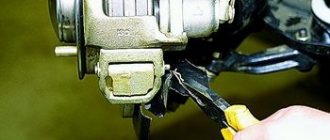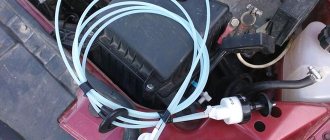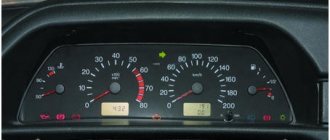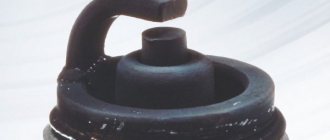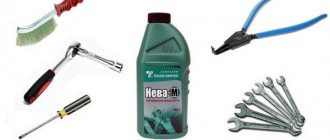How to bleed brakes on a VAZ-2107
Sometimes circumstances arise when the system in the VAZ-2107 is unproductive or there is a brake fluid leak (hereinafter referred to as TF). In such situations, it is necessary to immediately undertake repairs. It’s time to do the work on your own. To do this, you will need to prepare the equipment in advance and study the instructions.
The safety of any car, and the VAZ-2107 is no exception, directly depends on the effective operation of the braking system. When problems appear or repairs are made, the brakes need to be pumped. In order for the system to be in good condition, it is important to have knowledge of how damage occurs and what causes it.
Let's start the conversation with the sequence, and then move on to a description of the process. You know that the brake system of the VAZ 2107 and other domestic classics has two circuits, or more precisely, three. The first is the front wheels, it consists of two separate lines, it is customary to combine it into one circuit of the front brake mechanisms. The second is the rear wheels. From the main brake cylinder there is one brake pipe going to the “stern” of the car, which is divided into each side of the rear axle. Based on the design, you need to start pumping from the farthest element of the system - the right rear wheel.
Important! Each circuit swings separately, from the beginning we deal exclusively with one, let’s say the rear one, then we move on to the front. If the sequence is violated, problems may arise in the adequacy of the brakes.
Having released the air from the right rear mechanism, we move on to the left rear one. Having finished with it, we move on to the right front, and then to the left front. We start pumping from the farthest section from the GTZ (it is located under the hood on the left side) - this is the rear contour, the right side, then the left, then the farthest section of the front contour - the right side, then the left.
If you replaced the master cylinder, you first need to bleed the air from it
- Fill the brake fluid into the reservoir
- We “fit” the fittings of the brake pipes into the outlet holes of the cylinder. Don't tighten them, just wind them a couple of turns. This is necessary so that air can freely escape from the junction of the tubes and the GTZ housing
- When pouring brake fluid into the reservoir, it can flow out of the fittings by gravity. Otherwise, ask an assistant to press the brake pedal several times. The liquid will not emit a fountain from loosely twisted tubes. First, air will come out, you will see characteristic bubbles, then the liquid itself will begin to ooze.
- Make sure all connections are leaking evenly. Only after this do we tighten the fittings of the lines and wipe these places with a dry cloth
Video on how to bleed the master brake cylinder or why the system is not bleeding:
Replacing the brake hose
- Remove the front tire from the desired side so that there is convenient access to the caliper.
- Unscrew the bolt securing the hose from the reverse side and remove it with copper washers.
- Unscrew the hose in the area of fixation to the brake pipe.
During repairs, washers are replaced with new ones, as they are used as seals. And, as you know, when dismantling old parts, leakage of brake fluid cannot be ruled out.
The rear hose is attached in the same way, the only difference is that the front brake hose is fixed to the caliper with a bolt, the rear one with a nut. You will need wrenches to disconnect the tube and hose. One needs to unscrew the tube, the other needs to hold the nut of the flexible component. When the tube is slightly loosened, you need to remove the stopper using pliers. Having finished dismantling the damaged part, you need to install a new one. At the end of the process, the tank should be filled with TJ, and then the system should be pumped into the VAZ-2107.
How to bleed the brake system on a VAZ 2107 yourself
If the brakes do not work well, then while driving the risk of an emergency on the road increases, as a result of which all road users, as well as the driver and passengers, are exposed to danger. Therefore, it is necessary to ensure that the brake system (TS) functions flawlessly and to bleed it after repair and maintenance work to replace the working fluid or if air pockets form in it.
Reasons for performing the brake bleeding procedure
Bleeding is performed to remove air from the vehicle. This procedure is necessary after replacing the brake fluid (BF) during routine maintenance work or if it has changed color. Typically, on a VAZ 2107, a complete replacement of the TZ is done after three years. The procedure consists of stages: draining the old fluid, filling in new fluid and bleeding the brake system.
For the VAZ 2107, the manufacturer recommends using TJ DOT-4, its volume is 0.382 liters. It is recommended to add the same liquid that was previously filled. The TJ must meet the manufacturer's recommendations. It contains special additives that protect metal parts from corrosion. Over time, the liquid loses its properties; foreign particles enter it, which have a destructive effect on the elements of the system. These are several reasons why the TJ needs to be replaced. After which it is necessary to bleed the system.
In addition, pumping is mandatory:
- if parts were replaced or dismantled;
- after tuning;
- if the brake hoses are worn out, the vehicle is depressurized;
- The fuel fluid level in the tank has dropped below the minimum.
When the hoses are disconnected, air pockets may form in the hydraulic drive. The danger of its presence in a vehicle is that it makes braking unreliable. When the driver presses the brake, the brake pads on the wheel with air pockets in the circuit do not work, and it continues to spin.
You can tell that there is air in the hydraulic drive by the behavior of the brake pedal and the following signs:
- if you press it several times and at first it presses lightly, and then each time it becomes harder;
- the pedal stroke increases;
- the pedal often falls to the floor;
- braking distance increases;
- When braking, the car pulls away from the direction in which it was moving.
Bleeding is carried out using rolling fittings located on the brake units of each wheel. On the front wheels they are located on the caliper and covered with a cap.
In order to carry out the procedure correctly, you need to know that the vehicle of classic VAZs consists of two independent circuits. One includes the front wheels under the driver and passenger. In the second - the rear ones. If one of the circuits fails, the other continues to operate. If air has penetrated into one circuit, then you need to pump it out, but do not touch the other. This situation may arise when repairing the brake unit of one of the wheels.
Step-by-step instructions for the procedure
To carry out pumping work, two people will be needed. One goes down under the car, working with the brake system mechanisms. The other is in the cabin, pressing the brake pedal at the command of the person below. During work, you need to monitor the level of fuel fluid in the tank; it should always be at the maximum. If the level is below the minimum, air may enter the vehicle from the tank and the pumping procedure will have to be repeated.
What if without an assistant?
You can bleed the brakes on a VAZ-2107 without an assistant, but to do this you will have to slightly modify the design of the expansion tank cap. You need to buy a new cover into which you install the fitting from a regular camera. Now you need to create pressure in the system - this can be done using a camera or tubeless wheel. Inflate using a compressor and do the following:
- Fill the expansion tank with brake fluid.
- Install a cover with a fitting on it.
- Connect the fitting on the cover and the chamber using a tube.
- In this case, there is no need to install spool valves inside - they will be superfluous.
- Carry out repairs following the brake bleeding sequence described above.
Do not forget to add fluid to the system, otherwise an air lock will appear in it. You will have to bleed the brakes again. The VAZ-2107 uses the brand of fluid “RosDot-3” or “RosDot-4”. Try to use only those fluids recommended by the manufacturer.
Bleeding the brakes of a VAZ 2107 requires that an assistant sits behind the wheel and, at the command of the mechanic who performed the replacement, responds to shouts of “pump!” actively pumping up pressure in the system to expel air from it. "Hold it!" - meant that the mechanic unscrewed the fitting and the air, along with the old fluid, came out through the tube. The pedal had to be at the very bottom before the “Start!” command was received. In this case, among the special devices for pumping it was necessary to have:
- container for pumping and draining old fluid;
- a nylon tube with such a diameter that it fits flush onto the fitting;
- a spanner for bleeding, so that it is convenient to unscrew the fitting;
- a tube tip (optional), which worked as a check valve and was taken from the washer reservoir.
Later, even on sale, in the heyday of cooperative trade, special caps for the brake fluid reservoir, in which a nipple from a tubeless tire was embedded. Hit of the late 80s. We'll tell you how to use it right now.
Brake bleeding devices
The plant officially recognized only one method of bleeding the brakes - the one described in the user manual. But inventive car enthusiasts found more and more new options for how to bleed the brakes on a VAZ 2107. In principle, two people needed to bleed the brakes. According to the old habit, when the line systems were unreliable, the brake cylinders were bulky and bulky. In the seven, it was possible to completely replace the brake fluid in 15 minutes, without any difficulties, even alone.
After working on the brakes, it is recommended to bleed the brake system, unless of course we are talking about replacing the pads or adjusting the handbrake. Bleeding the brakes does not seem to be a very complicated procedure, but it requires scrupulousness, attention and some skill. If you have special equipment, you can bleed the brakes yourself. But, as a rule, brake bleeding is done with an assistant, and we will describe this process.
Signs of brake fluid loss of quality
- Increasing the length of the path to a complete stop of the car;
- Pressing the brake pedal requires force;
- The pillbox in the expansion tank changed color from light to dark;
- At the place where the tank is installed, traces of lubricant leakage are visible, the level is below normal;
- The yellow indicator on the dashboard indicates the fluid level sensor in the system.
If one or more signs are detected, stop the car, turn off the engine, and inspect the brake circuit and master cylinder. Subsequent operation of the technical device is unsafe.
When to bleed the brakes
The brake system on a VAZ 2107 car begins with the pedal and ends with brake pads with discs at the front and drums at the rear. The principle of operation of brakes is based on increasing the pressure of the fluid filling the entire system. The fluid pressure increases due to the displacement of the piston in the design of the master cylinder (by pressing the pedal). Next, the pistons move in the calipers (working cylinders) and they put pressure on the front and rear pads and stop the car. For the brakes to work effectively, all parts must be in good working order and there must be no air in the system.
Bleeding the brake system on the seven is carried out under the appropriate conditions:
- When is the fluid replaced? Usually it is recommended to change it every 40-50 thousand kilometers.
- When carrying out repairs, the brake cylinders and hoses, the expansion tank are changed, and the master and working cylinders are also repaired. When replacing pads, bleeding the brakes is not necessary.
- If signs of fluid leakage are detected.
- If brake performance deteriorates. In this case, you must first make sure what may be causing the deterioration in braking quality. Air penetration into the system is one of the main signs of reduced braking quality.
If air gets into the system, its efficiency decreases.
What you need for pumping
Before you begin the procedure, you will need to take the appropriate tools. It must be said right away that the pumping procedure is not difficult, but it will require two people. One is located inside the car and presses the brake pedal. The second is located in the inspection hole, for the rear wheels or on the side, when pumping the front wheels, which are previously dismantled.
To bleed the brake system on a VAZ 2107, you should stock up on the following tools:
- Wrench for brake pipes (special) 8 mm and 10 mm.
- Open-end wrench for 8 mm and 10 mm.
- The hose is transparent with the appropriate diameter and length for fitting onto the caliper bleed valve rod.
- A container for draining liquid from the system when pumping it.
- Brake fluid.
If the design of the caliper contains fittings with a key of “8”, then it is necessary to replace them with the same ones, but only with a key of “10”. These fittings are much stronger and stronger, so it is better to replace them immediately.
How to bleed the brakes on a VAZ 2107
Many people consider the process of repairing brakes to be a complex and responsible undertaking, so they do not risk carrying out its repair. The maximum that most car owners are willing to do is replace the pads. However, both the repair and the process of bleeding the brake system on the seven does not present any difficulties. You need to do everything according to the instructions once, so that next time you can do everything automatically.
Soft and stiff brake pedal
The normal position of the brake pedal of the 2107 model is when there are no jerks or dips when pressed, and no effort is required. At the same time, during the operation of the car, car owners are sometimes faced with the fact that the brake pedal manifests itself in a completely different way, that is, it becomes too tight or soft.
Such manifestations are unacceptable and indicate problems in the braking system. Therefore, prompt repairs are required. Often the pedal becomes soft when the system is too airy. This phenomenon is also called failure. The damage can be repaired by bleeding the brakes, that is, it is necessary to remove accumulated air from the system. The latter could have happened due to the following reasons:
- not enough fuel fluid in the expansion tank;
- sealing in the braking system is broken;
- damage to the brake cylinder.
At the same time, there is a situation where when pressing the pedal it requires excessive force, for which the vacuum booster (VA) is to blame. This mechanism creates a vacuum in the manifold (intake). The fact that the pedal is tight is indicated by a number of reasons:
- the VU air filter is clogged, therefore, it needs to be replaced;
- the VU valve body is jammed; the vacuum booster should be replaced;
- the VU diaphragm is damaged; replacement of the control unit is required;
- wear of the tip of the device; the tip needs to be replaced;
- incorrect operation of the check valve in the control unit; it is worth replacing;
- the seal is broken; the VU or check valve should be replaced;
- damage to the hose connecting the intake manifold and the intake manifold, or the tightening of the clamp in it is loose;
- increasing the size of cuff cylinders in brake cylinders; this happens when using poor quality fuel fluid.
Bleeding the brake system
Let's proceed directly to pumping. Before describing this generally technically simple process, we note that it is almost identical for all the “classics” of the Volzhsky Automobile Plant. In other words, bleeding the brakes of a VAZ 2106 is similar to bleeding the brake system of a VAZ.
The bleeding procedure should begin from the contour of the rear wheel pair, more precisely from the wheel farthest from the main elements of the braking system - the rear right one. Next, the following manipulations are performed:
The assistant sits in the cabin and, having made several presses on the brake pedal (the pedal stops in the upper position), fixes it in the pressed state.
Place the hose onto the fitting of the working brake cylinder, then unscrew it (the fitting) half a turn using a spanner or open-end wrench set to “8” (to “10”).
Monitor the passage of brake fluid with air bubbles through the hose.
As soon as the movement of liquid and air stops, tighten the fitting.
Attention! The brake pedal is held in the pressed position until the fitting is completely screwed in.
Repeat the above-described manipulations until the air disappears from the brake fluid flowing out of the hose.
Tighten the brake cylinder fitting and disconnect the hose.
Repeat the above procedure with the left wheel of the rear wheelset, and then with the brake circuit of the front wheelset.
During the entire process of bleeding the brake system, monitor the level of brake fluid in the expansion tank.
Having completed removing air from the front and rear brake circuits, perform the procedure for “de-airing” the master brake cylinder (hereinafter referred to as the main brake cylinder). The assistant performs manipulations in the cabin similar to those described above, and you will have to alternately disconnect the tubes from the GTZ.
After completing the work on pumping the brakes, check their functionality while the vehicle is moving.
WHY DO NOT THE BRAKES BLEND?
One of the problems that many VAZ 2107 owners face is the inability to bleed the brakes after repairing or replacing the master cylinder. It would seem that a new or repaired part has been installed, bleeding is carried out correctly, but the result is zero. The essence of the problem is that in most cases, when installing a GTZ, tubes and hoses are first connected to it, then brake fluid is poured into the reservoir, and only after that they begin bleeding. However, there is air in the cylinder itself, so you need to bleed it first, and then start working on the brakes.
The fact that there is air in the GTZ is also indicated by the brake pedal, which lies on the floor.
To deal with the problem, you do not need to tighten the fittings on the tubes - just tighten them. After this, pour brake fluid into the reservoir and release the fittings a few turns so that fluid and air flow out of them. Alternatively, to speed up the process, you can wipe the neck of the tank and blow into it to create pressure. After the fluid flows without air, the fittings are clamped and the standard procedure for bleeding the brakes begins.
To bleed the GTZ, unscrew the fittings on the tubes
In addition, a pumping problem can occur when installing a defective cylinder or when a part is incorrectly repaired. If a problematic product is encountered, the fluid is bypassed, which simply flows from the tank to the cylinder and back, i.e. it does not pass further than the GTZ. In this case, the part must be replaced. If the cylinder has been repaired, the procedure will need to be repeated, since, most likely, an error was made during assembly.
In order for the “Seven” brake system to work properly, it is necessary to periodically inspect its elements, monitor the level of brake fluid in the expansion tank, and if it decreases, identify the reason that led to this. Since many problems with the hydraulic brake system require bleeding, you need to know what should be done and in what order - there is nothing complicated in this process.
Let's answer some frequently asked questions
Is it possible to bleed the front or rear brakes separately on a classic?
Can. Moreover, you can separately swing the left and right mechanisms of one axis. The rear and front contours are not connected to each other if the entire cuffs are in the GTZ. Therefore, the risk of airing your neighbor is minimal. Agree, when replacing the front brake cylinder, only it is pumped, not the entire system. This also applies to the rear wheels. Repeatedly, when changing the rear cylinder on classic Zhiguli cars, I only pumped it. After this, all mechanisms continued to work properly.

